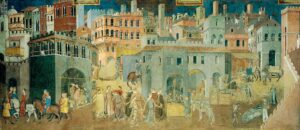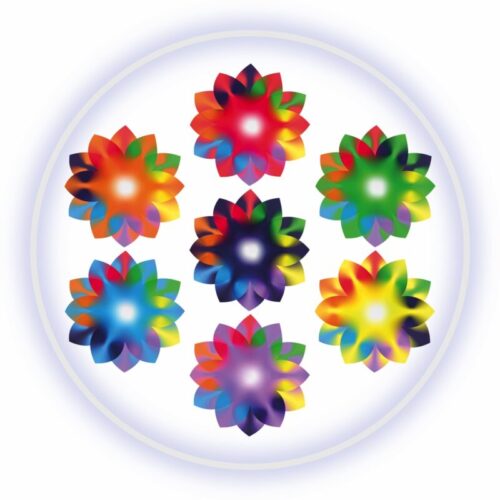“There are people who, unbeknown to one another, are saving the world”.
Thus we paraphrase a line from a poem by Jorge Luis Borges dedicated to the work of righteous men, while Khalil Gibran poetically points out that “When you work you are a flute turning in its heart the murmur of the hours to music”. [1]

Work is that energy that supports and enlivens the world, which weaves time and space into a precious arabesque of awareness, responsibility, connection, expression and realisation, mixed with effort and patience, but also imbued with light and beauty.
While man works, the world reveals itself in its structures and a network of manifestations, not only material but above all of values and beauty, emerges. Through work, man can transform chaos into order, he can affix his seal of understanding, he can give names to things so that the meaning of his existence becomes more real and leads him to fullness.
A man who works forges matter and reshapes it, innervating it with meaning; Humanity that works redefines its purpose and destination every moment, especially in these times when work, manual or intellectual, groans under the weight of a crisis which is severe but fraught with future possibilities.
In the same way a System (understood as a steadfast arrangement of elements, that is to say a Whole composed of different parts according to a rule and for a purpose) finds in the Work the field of its subjective expression.
The year 5.7 [2], nourished by the energies of the 5th and 7th Ray and dedicated to celebrating the creative Liturgy of the Group and of Work, well supports this commitment and this “constructive battle” since “Fighting is like building” [3].

The Teaching reminds us, not by chance, that: “Not only does knowledge lead to the Higher World, but labor also. Indeed, each labor is knowledge. Thus, labor is prayer” [4];
“The simple truth that labor is prayer is not always clear to people, and a good deed is accomplished when one repeats this truth” [5];
“The rhythm of labor is the adornment of the world. Labor may be regarded as a victory over everyday routine. Each hard-working man is a benefactor of humanity. To imagine Earth without workers is to see a reversion to chaos. Invincible tenacity is forged by labor; precisely everyday work is the accumulation of the treasure. The true toiler loves his labor and understands the significance of tension. Work has already been called prayer. The highest unity and quality of labor arises from its rhythm. The best quality of work brings forth the rhythm of the Beautiful. Each labor contains within itself the concept of the Beautiful. Labor, prayer, beauty—all are facets of the great crystal of Existence” [6];
“On the path of labor rhythm is cognized and also the concept of energy. On the path it is truly possible to realize movement and harmony. Amid enormous tasks one may discern the sparks of inspiration. He who labors will be a co-worker” [7].
Many other concepts are therefore connected to the idea of work, concepts that allow us to lay the foundations for tracing its main lines: responsibility, tension, commitment, collaboration. And that’s not all; all these features are coloured with beauty and sacredness, they urge human activity in search of a superior quality of work where commitment is not only external but starts from that inner impulse that pushes man to create in joy, thus making himself co-creator of the Manifestation.
An ordered and cohesive Group, a System, operates in this direction, guides all its energies in the activation of that model (albeit partial) of the Plan which allows the maximum tension of individual and group energies and which merges every effort in the ignition of the lines of the common future. A System works for the Common Good, oblivious of the individual and group self, it keeps alight in itself and in Humanity the fiery torch of the spirit, which reveals the smile of joy, the wage of the Workers.
“I affirm that the joy of labor is the best flame of spirit. The manifestation of joy is accompanied by intensified activity of the centers. Many great achievements come through the manifestation of joy.” [8];
“Urusvati knows the true meaning of labor. We affirm labor as the universal value. We call labor the source of healing rhythm. We repeat that labor provides real joy to the worker. We place labor into the foundation of the family and the state. But now We must add one more, the most significant quality of labor – that it gives joy not only to the worker himself, but also to others. Any labor undoubtedly gives joy to someone. The joy may not be great, but it might also be vast. The manifestation of universal joy is produced by labor” [9].
It seems unusual to combine joy with work, when millions of human beings are brutalised by monotonous and exhausting work, poorly paid and exploited, slaves to the desires they hope to satisfy by working and by which they are chained to a job that deprives them of satisfaction and possibilities of expression.
The Teaching emphasises that work weighs when the forces are badly distributed, when there is no understanding nor purpose in the work done, when the consciousness is unable to grasp the sacredness of the work nor its being a veil of the creative energy that animates mankind and finally when you work only to collect a payment, separating work from its function of collective creation for the common good.
Yet when work appears in its creative essence, our gaze manages to penetrate beyond the mists of dissatisfaction and lack of meaning, since every work carries within itself the germ of its own transfiguration: thus every work is in its essence purpose, education, designing and constructive intelligence, beauty, communion and order.

“If the tiller of the soil is only a daily slave, his labor will never expand. Each form of work has a creative domain. Earthly thought binds one within earthly limits, but evolution contains the Higher Principle. Books should be written on the different domains of labor. Therein servile, circumscribed toil should be compared with unbounded creative labor. It is necessary to demonstrate in a strictly scientific manner the possibilities which can be reached through a regeneration of the quality of labor. People who are depressed by the daily routine lose sight of the horizon. So, too, the eyes of man cannot at once become accustomed to the light. Let science in all ways aid the expansion of the horizon” [10].
In this way, every System that strives along the lines that innervate human advancement, works for human development, works to build Brotherhood: “The path to Brotherhood is in thinking and in labor”, “Whoever can rejoice at each day’s labor is on the way to Brotherhood”, “Work and lofty thought will be the arms of victory — such is the path of Brotherhood” [11].

Following this Path also means working for Infinity and infinitely:
“People often talk about untiring labor, but in their spirit, they fear it. One cannot name anyone who, without broadening of consciousness, can find joy in endless labor. Only Our people will understand how life is fused with labor, drawing from it strength of achievement. It can be understood that, just as fire is inexhaustible, so also is the energy that is derived from labor. The fulfillment of Agni Yoga begins from the moment of realization of labor. But if the energy to sustain the fire is insufficient, cloudbursts will begin to extinguish it. The tension of energy does not come from a command of the mind, nor does it increase by a command from without. It grows only from within. However, only a free consciousness can transform labor into a festival of spirit” [12];
“People loathe especially the routine of daily life; for them it is the symbol of weariness and descent, whereas for us the daily routine is perfectment and ascent; it opens the gates to Infinity. One can learn to love this daily routine, because it tempers the spirit and gives one courage to contemplate the endless chain of the ages of labor. For some, these ages are a menace, but a refined consciousness will accept them as the source of endless creativeness” [13].
From work to Work (or from service to Service) man therefore proceeds on the Path of evolution; at first unaware then conscious of his task as creator, he advances on the path; at first solitary and then in a Group he traces the lines of that layout which is called the Kingdom of Heaven and which he is summoned to forge with his own hands, his intelligence, his heart.
The prototype for a Planetary Order, a System of fiery hearts that works in the heart of Humanity, tirelessly nurtures this creative work and attracts other hearts to the neverending Work which is the glory of the One.

“Blessed is true cooperation; in it is the element of space. As Infinity ceaselessly flashes out in each spark of an electrical discharge, so, too, common labor engenders limitless effects. Therefore, let us not call labor small and of no consequence; no spatial spark should be condemned by man. The quality of spaciousness should be reverenced as something supermundane. And so labor is a furnace of supermundane sparks” [14].
1. Lines from “The Righteous” by Jorge Luis Borges and “The Prophet” by Khalil Gibran
2. The fifth seven-year period (in a systemic matrix, or Table of the Plan, which includes 7 seven-year periods) opened with the December Solstice of 2014, at the same time starting the year 5.1. With the winter Solstice of 2020, the year 5.7 began, dedicated to the sacred Rituals of the Group and of the Work, urging every consciousness to the realisation of the New Culture. This article, in accordance with the cyclical motions of the Heavens that act as a Model for every cultural and constructive action, is published on the occasion of the conjunction between Saturn and Mercury, in Aquarius, radiant sources of the 3rd and 4th Ray, Plan and Model, primary bricks, essential to build any System devoted to planetary Service.
3. Enzio Savoini, Rituals ’92, Ritual of Scorpio (unpublished text)
4. Agni Yoga Series – Aum § 62
5. Supermundane II § 440
6. Aum § 322
7. Aum § 600
8. Agni Yoga § 459
9. Supermundane IV § 844
10. Aum § 301
11. Brotherhood § 85, 350, 578
12. Agni Yoga § 347
13. Hierarchy § 176
14. Brotherhood § 548






Love, Love Love This!!… Courage to Continue!… thank you so much… and when we Do This Labor… there is a Response!…